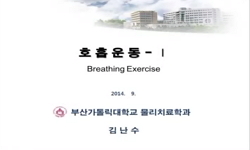The effects of hyperglycemia and hyperlipidemia on utilization of muscle glycogen during 45 minute session of treadmill running (26 m/min, 8 % grade) were evaluated using Sprague Dawley rats, and the characteristics of the 4 different type of muscles,...
http://chineseinput.net/에서 pinyin(병음)방식으로 중국어를 변환할 수 있습니다.
변환된 중국어를 복사하여 사용하시면 됩니다.
- 中文 을 입력하시려면 zhongwen을 입력하시고 space를누르시면됩니다.
- 北京 을 입력하시려면 beijing을 입력하시고 space를 누르시면 됩니다.

횐쥐에서 고혈당 및 고지질혈증이 운동 중 골격근 당원이용에 미치는 영향 = The Effects of Hyperglycemia and Hyperlipidemia on Muscle Glycogen Utilization during Exercise in Rate
한글로보기https://www.riss.kr/link?id=A60128438
- 저자
- 발행기관
- 학술지명
- 권호사항
-
발행연도
1999
-
작성언어
-
- 주제어
-
KDC
500
-
등재정보
KCI등재
-
자료형태
학술저널
- 발행기관 URL
-
수록면
34-42(9쪽)
- 제공처
-
0
상세조회 -
0
다운로드
부가정보
다국어 초록 (Multilingual Abstract)
The effects of hyperglycemia and hyperlipidemia on utilization of muscle glycogen during 45 minute session of treadmill running (26 m/min, 8 % grade) were evaluated using Sprague Dawley rats, and the characteristics of the 4 different type of muscles, i.c., soleus, white and red gastrocnemius, and plantaris, on glycogen utilization were simultaneously investigated. Hyperglycemia was induced by 145-165 ㎎/dL of oral glucose administration, and hyperlipidemia was induced by combined treatment of intraperitoneal heparine injection of 444 uEq/L and 10 % intralipose oral adminstration. During the hyperglycemic trial, the glycogen utilization of plantaris muscle was decreased by 13 % in 45 minute session of treadmill running compared to the control trial (p<0.05), and the glycogen utilization of while gastrocnemius was also decreased. The sparing tendency of glycogen was observed in soleus and red gastrocnemius by 5-13 % during 30 and 45 minute session of treadmill running in hyperglycemic trial. There was no glycogen sparing effect of hyperlipidemia in soleus, red gastrocnemius and plantaris muscle subjected in this experiment during exercise. However, only a slight sparing tendency of white gastrocnemius muscle was observed. In summary, the glycogen sparing effect of hyperglycemia during exercise was observed in plantaris and white gastrocnemius muscles in rats. However, there was no glycogen sparing effect of hyperlipidemia in the 4 hindlimb muscles. It was observed that the glycogen sparing effect of hyperglycemia is more prominent in fast glycolytic muscle fibera.
동일학술지(권/호) 다른 논문
-
대측 신장이 정상인 신종양 환자에서 신보존수술의 임상 경험
- 영남대학교 의과대학
- 박동춘
- 1999
- KCI등재
-
- 영남대학교 의과대학
- 김세동
- 1999
- KCI등재
-
본태성 고혈압에 대한 Imidapril의 강압효과 및 마른기침 발현율에 대한 고찰
- 영남대학교 의과대학
- 신동구
- 1999
- KCI등재
-
- 영남대학교 의과대학
- 이은영
- 1999
- KCI등재




 KISS
KISS






